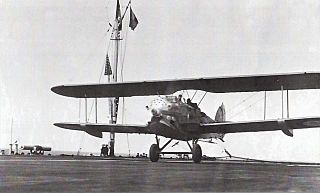
The Bréguet 280T was a French biplane airliner of the late 1920s, created by the manufacturer as a means of finding a civil market for their 19 warplane, as they had once tried before with the 26T.

The Levasseur PL.4, aka Levasseur Marin, was a carrier-based reconnaissance aircraft produced in France in the 1920s.

The Levasseur PL.5 was a carrier-based fighter produced in France in the late 1920s, in response to the 1924 AMBC.2 specification issued by the Service Technique de l'Aéronautique (STAé). It was a conventional, single-bay sesquiplane that carried a crew of two in tandem, open cockpits. Like other Levasseur naval designs of the day, it incorporated several safety features in case of ditching at sea. Apart from small floats attached directly to the undersides of the lower wing, the main units of the fixed, tail-skid undercarriage could be jettisoned in flight, and the underside of the fuselage was given a boat-like shape and made watertight.

The Levasseur PL.7 was a torpedo bomber developed in France in the late 1920s. It was a development of Levasseur's PL.4 reconnaissance aircraft and intended to replace their PL.2 then in service with the Aéronavale. It was a single-bay biplane of largely conventional design, but incorporating safety features for naval operation, including jetissonable main undercarriage units, a watertight, boat-shaped fuselage, and small floats on the undersides of the lower wings.

The Levasseur PL.10 was a carrier-based reconnaissance aircraft developed in France in the late 1920s. It was a conventional, single-bay biplane along similar lines to Levasseur's contemporary designs for the French navy, including a watertight, boat-shaped fuselage, small underwing floats, and undercarriage that could be jettisoned in flight in order to improve the changes of a successful ditching.

The Villiers II was a French two-seat fighter aircraft of the 1920s intended for operation from the Aircraft carrier Béarn of the French Navy. It was a single-engined tractor biplane with a waterproof hull in the form of a flying boat to allow the aircraft to be safely landed on water in an emergency. Two prototypes and 30 production aircraft were built, the type serving briefly with the French Navy, although never operated from an aircraft carrier.
The Latécoère 440 was a single-engined, high-winged float plane built as a coastal defence aircraft for the French Navy in the early 1930s. Two were produced to contract but did not impress in tests and the Navy chose instead the Latécoère 290.
The IAR 13 is a Romanian low-wing monoplane fighter-trainer aircraft designed before World War II.

The IAR 16 was a low-wing monoplane fighter designed in Romania in 1934.

The Fokker D.XII was a Dutch single seat, single engine fighter aircraft designed to an American specification which called for the use of a Curtiss D-12 engine, designated PW-7. Despite considerable efforts to improve the airframe, Fokker failed to win the USAAS competition.

The Nieuport-Delage NiD 43 was a single-engine, two-seat biplane fighter aircraft designed and built for shipboard use in France in 1924.
The Dewoitine D.15 was a single-engine, single-seat biplane fighter aircraft built in France in the 1920s. Intended to offer structural simplifications when compared with monoplanes, it had a disappointing performance and was soon abandoned.

The Hanriot HD.15 was a French two seat fighter aircraft fitted with a supercharger for good high altitude performance, built in the 1920s. Three were ordered by Japan but lost at sea during delivery.

The Hanriot H.26 was a French single seat fighter aircraft prototype completed in 1923. Only one was built.

The Potez-CAMS 161 was a large, French six-engined flying boat airliner, designed to operate on the North Atlantic routes that were opening up in the late 1930s. Its development was almost halted by World War II. Just one was built and partially tested before its destruction by Allied forces near the war's end.
The Potez 26 was a single seat fighter aircraft designed and flown in France in the mid-1920s. It did not reach production.

The Blériot-SPAD S.91 was a French light-weight fighter aircraft. It would be later developed into the Blériot-SPAD S.510, the last biplane produced by the French aeronautic industries.

The Caudron C.140 was a French tandem cockpit sesquiplane designed in 1928 as a combination of liaison aircraft and observer and gunnery trainer.

The Caudron C.39 was a French three-engined biplane with a cabin for six passengers when the aircraft was equipped as a landplane or four passengers when on floats. It was flown with some success in competitions in 1920 and 1921.
The Villiers VIII or 8amC1 was a French shipboard fighter capable of alighting on water. After competitive tests, it did not receive a production order.
















